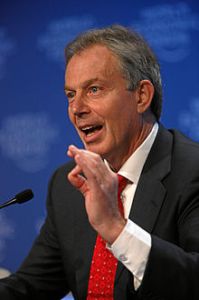The ninth collection of UFO files, released by the UK government on 12 July, takes the chronology full circle back to the MoD’s decision to ‘make UFOs history’.
A guide to the highlights of the 25 files can be found on the The National Archives UFO page here and a more detailed analysis can be found on my UFO files #9 page here. I’ve blogged about the files as a guest on the archives blogpage here.
The documents reveal how influential my Freedom of Information campaign actually was in the decision to end decades of official secrecy by opening the files to the public.
Within the 6,700 pages is a UFO briefing prepared for former Prime Minister Tony Blair by the Ministry of Defence in 1998. New Labour’s manifesto included a commitment to a Freedom of Information bill and UFOlogist Nick Redfern took the initiative in a letter to No.10 that urged Mr Blair to ‘consider making available for public scrutiny all of the many and varied UFO reports’ collected by the government since the end of the Second World War [DEFE 24/1987/1]

Tony Blair once said his ‘worst mistake’ in government was the Freedom of Information Act (credit: Wikipedia)
Every new Prime Minister receives requests to release UFO data but from January 2005 – when FOIA was rolled out across central government – the pressure to disclose the files could not be resisted. Within six months the topic became one of the three most popular subjects for requests to the MoD.
For most of that decade I was one of the MoD’s most ‘persistent correspondents’, filing FOI requests on a weekly basis. Working as an investigative journalist, I focussed most of my requests around those UFO stories that appeared to have a strong public interest element. As a result almost a third of the material contained in this tranche of files chronicle the working relationship that I developed with the UFO desk officers. You can follow my correspondence with those who ran what are often called ‘the real X-files’ in DEFE 24/2043/1, DEFE 24/2061/1 and DEFE 24/2090/1.
The campaign resulted in several invitations to MoD Main Bulding where I met officials to discuss how UFO sightings were investigated and their future plans for the release of documents. In hindsight, on reading the minutes of one meeting I attended in 2004, it is obvious that MoD were working towards the day when they could transfer all their records to a public archive as the United States had done in 1970.[DEFE 24/2061/1]
So it was no real surprise to learn that, soon afterwards, a decision was taken to transfer all the surviving files to The National Archives at Kew. This was followed in 2009 by an announcement that the UFO desk and its telephone hotline service – set up on the 50th anniversary of the Roswell incident in 1997 – were to be terminated. After almost 60 years, the ‘real X-files’ were closed for good.
One of the newly released files, DEFE 24/2080/1 is a collection of UFO policy papers generated by the MoD’s defence intelligence staff over a 30 year period. They reveal that intelligence officers had no more specialist knowledge about UFOs than the average person in the street. For example, shortly before the subject was debated by the House of Lords in 1979 DI55 officer asked a government spokesman why, in such a vast universe, aliens would want to visit ‘an insignificant planet (the Earth) of an uninteresting star (the sun).’ He said even if intelligent aliens existed, the earth should expect a visit perhaps once in every thousand years, so ‘claims of thousands of visits in the last decade…are far too large to be credible.’
Other officials were more optimistic about the possibility of alien visitors. Indeed, these documents reveal some ‘wanted to believe’ so passionately that they tended to be less than critical of the ‘evidence’ published by the UFO industry. For example, in 1995 the DI55 UFO officer cited the so-called Cosford incident in a briefing to the Defence Intelligence Staff to obtain funding for a UFO study. A basic literature review would have revealed this sighting was triggered by the re-entry into earth’s atmosphere of a Soviet rocket body, Cosmos 2238.
And while some mysteries do remain, one popular misconception debunked by the files is the idea that MoD operated a secret squirrel ‘UFO Project’ similar to that depicted in the TV series The X-files. In a 2008 briefing on the ‘daily mechanics’ of the strangest job in Whitehall, the last MoD UFO desk officer Paul Webb wrote that the idea of official investigations ‘tends to suggest to the public that there are Top Secret teams of specialist scientists scurrying around the country in a real life version of the X-Files’. But striking a note of disappointment he admitted this was ‘total fiction’ and most ‘investigations’ were carried out by ‘googling the internet.’
Since the TNA began to release UFO papers four years ago, 178 files have been released and the 9th tranche brings the number of pages disclosed to 50,000.
You can read a more detailed account of the file content on my TNA UFO files #9 here.
All 25 new files can be downloaded from http://www.nationalarchives.gov.uk/ufos
The second edition of my book The UFO Files – fully updated with a new chapter on the closure of the UFO desk – is published by Bloomsbury on 13 September.

It is a mistake to assume that our Earth is an “insignificant planet”. If Earth is the only planet , either in our Solar System, Galaxy, or perhaps the entire Universe, where 3- Dimensional physical life exists, then it will undoubtedly be of great significance Indeed to our non-terrestrial and non-physical Visitors, who are in my understanding higher-frequency Beings from another Dimension.